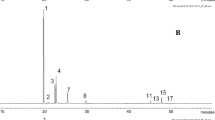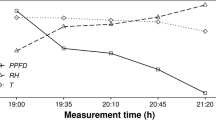Abstract
The difference in cone colonization by specialized insects that had been observed between Swiss stone pine (Pinus cembra L.) and mountain pine (P. uncinata Ram.) prompted us to test whether volatiles and oleoresin of Swiss stone pine cones may serve as a barrier for insect attack. The volatiles emitted by cones of both pine species were sampled using headspace techniques in the French Alps. The cone volatiles of both species essentially consisted of seven similar monoterpenes, but the terpene profiles markedly differed between species. α-Pinene (67% of the total), β-pinene, and limonene + β-phellandrene were dominant in the cone volatiles of Swiss stone pine, while the cone emissions of mountain pine showed no dominant terpenoid. The cone oleoresin of P. cembra significantly differed from cone volatiles by a lower level of α-pinene and higher levels of β-pinene and limonene + β-phellandrene. Field sprays of mountain pine cones with oleoresin extracts of Swiss stone pine cones significantly reduced the overall damage of specialized cone insects. None of the cones sprayed with oleoresin were attacked, whereas 11% and 31% of the unsprayed control cones were damaged by insects. Specific cone damage due to a cone weevil, Pissodes validirostris Gyll. (Coleoptera: Curculionidae), and a cone pyralid, Dioryctria mutatella Fuchs (Lepidoptera: Pyralidae), were significantly decreased in one year. The volatile profile of the sprayed cones differed markedly from that of unsprayed mountain pine cones, especially in the higher level of myrcene. However, the volatile profile of the sprayed cones also differed from that of the oleoresin extract used for spraying. The role of monoterpenes in protecting the sprayed cones from insect attack is discussed.
Similar content being viewed by others
REFERENCES
ALFARO, R. I., BORDEN, J. H., HARRIS, L. J., NIJHOLT, W. W., and MC MULLEN, L. H. 1984. Pine oil, a feeding deterrent for the white pine weevil, Pissodes strobi (Coleoptera: Curculionidae). Can. Entomol. 116:41–44.
ANNILA, E., and HILTUNEN, R. 1977. Damage by Pissodes validirostris (Coleoptera, Curculionidae) studied in relation to the monoterpene composition in Scots pine and lodgepole pine. Ann. Entomol. Fenn. 43:87–92.
BERNAYS, E. A, and CHAPMAN, R. F. 1994. Host-Plant Selection by Phytophagous Insects. Chapman and Hall, London.
BORG-KARLSON, A.-K., EIDMANN, H. H., LINDSTROM, M., NORIN T., and WIERSMA, N. 1985. Odoriferous compounds from the flowers of the conifers Picea abies, Pinus sylvestris, and Larix sibirica. Phytochemistry 24:455–456.
DETHIER, V. G., BARTON BROWNE, L., and SMITH, C. N. 1960. The designation of chemicals in terms of the responses they elicit from insects. J. Econ. Entomol. 53:134–136.
DICKENS, J. C. 1978. Olfactory perception of pheromone and host-odour enantiomers by Ips typographus (Coleoptera: Scolytidae). Entomol. Exp. Appl. 24:136–142.
DORMONT, L., ROQUES, A., and TROSSET, L. 1996. Insect damage to cones and other mortality factors limiting natural regeneration potential of Swiss stone pine (Pinus cembra L.) in the northern French Alps. Ann. Sci. For. 53:153–158.
DUBELL, V. 1992. The effectiveness of pine oil as a repellent against the striped ambrosia beetle, Trypodendron lineatum (Col., Scolytidae). J. Appl. Entomol. 114:91–97.
FLOROV, D. N. 1951. Pests of Pinus sibirica Mayr. I: Cone and seed pests of P. sibirica (in Russian). Obl. gosudarstv. Izdatel'stvo. Irkoutsk, pp. 8–28.
HAFIZOGLU, H., and REUNANEN, M. 1994. Composition of oleoresins from bark and cones of Abies nordmanniana and Picea orientalis. Holzforschung. 48:7–11.
HANULA, J. L., BERISFORD, C. W., and DEBARR, G. L. 1985. Monoterpene oviposition stimulants of Dioryctria amatella in volatiles from fusiform rust galls and second-year loblolly pine cones. J. Chem. Ecol. 11:943–952.
KHOMENTOVSKY, A., and EFREMOVA, L. S. 1991. Seed production and cone-feeding insects of Pinus pumila on the Kamtchatka peninsula: Aspects of coexistence, pp. 316–320, in Y. N. Baran-chikov, W. J. Mattson, F. P. Hain, and T. L. Payne (eds.). Forest Insect Guilds: Patterns of Interaction with Host Trees. USDA Forest Service Gen. Tech. NE-153.
KNUDSEN, J. T., TOLLSTEN, L., and BERGSTROM, L. G. 1993. Floral scents—a checklist of volatile compounds isolated by headspace techniques. Phytochemistry 33:253.
MARION-POLL, F., and THIÉRY, D. 1997. Olfactory sensitivity of Douglas-fir seed chalcid to plants odors, in G. L. DeBarr, J. J. Turgeon, A. Roques, and J. H. Sun (eds.). Proceedings, 4th International Conference, IUFRO Cone and Seed Insects Working Party. USDA Forest Service, Southeastern Forest Experiment Station Athens, Georgia. In press.
MATTSON, W. J., and STRAUSS, S. H. 1986. Are cone volatiles involved in cone finding by the red pine cone beetle, Conophtorus resinosae (Coleoptera Scolytidae)? pp. 185–196, in A. Roques (ed.). Proceedings 2nd International Conference, IUFRO Cone and Seed Insects Working Party. INRA, Olivet, France.
MONTI, L., LALANNE-CASSOU, B., LUCAS, P., MALOOSE, C., and SYLVAIN, J. F. 1995. Differences in sex pheromone communication systems of closely related species: Spodoptera latifascia Walker and S. descoinsi Lalanne-Cassou and Sylvain (Lepidoptera: Noctuidae). J. Chem. Ecol. 21:641–660.
NEHLIN, G., VALTEROVA, I., and BORG-KARLSON, A. K. 1994. Use of conifer volatiles to reduce injury caused by carrot psyllid, Trioza apicalis Forster (Homoptera, Psylloidea). J. Chem. Ecol. 20:771–783.
NORDLANDER, G. 1991. Host finding in the pine weevil Hylobius abietis: Effects of conifer volatiles and added limonene. Entomol, Exp. Appl. 59:229–237.
NORDLANDER, G., EIDMANN, H. H., JACOBSSON, U., NORDENHEM, H., and SJODIN. K. 1986. Orientation of the pine weevil Hylobius abietis to underground sources of host volatiles. Entomol. Exp. Appl. 41:91–100.
OSHKAEV, A. K. 1981. Role of monoterpenes in the interaction between trees and cone insects (in Russian). Noveïskie dostiskeniya entomologii, Vilnius.
RAPPAPORT, N. G., JENKINS, M. J., and ROQUES, A. 1997. Cone and foliage volatiles from Douglasfir and European larch: Relationships to attack by cone and seed insects, in G. L. DeBarr, J. J. Turgeon, A. Roques, and J. H. Sun (eds.). Proceedings, 4th International Conference, IUFRO Cone and Seed Insects Working Party. USDA Forest Service, Southeastern Forest Experiment Station, Athens, Georgia. In press.
ROQUES. A. 1987. Interaction between visual and olfactory signals in cone recognition by insect pests, pp. 153–160, in V. Labeyric, G. Fabres, and D. Lachaise (eds.). Proceedings, 6th International Symposium on Insect-Plant Relationships. Junk, Dordecht.
ROQUES, A., 1991. Structure, specificity, and evolution of insect guilds related to cones of conifers in western Europe, pp. 300–315, in Y. N. Baranchikov, W. J. Mattson, F. P. Hain, and T. L. Payne (eds.). Forest Insect Guilds: Patterns of Interaction with Host Trees. USDA Forest Service Gen. Tech. NE-153.
ROQUES, A. 1993. Impact of insects on natural regeneration of high altitude alpine stands, pp. 71–94, in T. Anfodillo and C. Urbinati (eds.). Ecologia delle Foreste d'Alta Quota, Universita di Padova, Padova.
ROQUES, A., RAIMBAULT, J. P., and GOUSSARD, F. 1983. Impact des insectes ravageurs des cônes et graines sur la régénération naturelle du pin à crochets (Pinus uncinata Ram.) dans quelques forêts de montagne des Alpes du Sud et les pyrérnées. Acta Biol. Montana 2:331–347.
ROSELAND, C. R., BATES, M. B., CARLSON, R. B., and OSETO, C. Y. 1992. Discrimination of sunflower volatiles by the red sunflower seed weevil. Entomol. Exp. Appl. 62:99–106.
SCHAFER, B., HENNIG, P., and ENGEWALD. W. 1995. Analysis of monoterpenes from conifer needles using solid phase microextraction. J. High Resolut. Chromatogr. 18:587–592.
THIÉRY, D., and VISSER, J. H. 1986. Masking of host plant odor in the olfactory orientation of the Colorado potato beetle. Entomol. Exp. Appl. 41:165–172.
TURGEON, J. J., ROQUES, A., and DE GROOT, P. 1994. Insect fauna of coniferous seed cones. Diversity, host-plant interactions, and management. Annu. Rev. Entomol. 39:179–212.
VISSER, J. H. 1986. Host odor perception in phytophagous insects. Annu. Rev. Entomol. 21:121–144.
VON RUDLOFF, E. 1975. Volatile leaf oil analysis in chemosystematic studies of North American conifers. Biochem. Syst. Ecol. 2:131–167.
Author information
Authors and Affiliations
Rights and permissions
About this article
Cite this article
Dormont, L., Roques, A. & Malosse, C. Efficiency of Spraying Mountain Pine Cones with Oleoresin of Swiss Stone Pine Cones to Prevent Insect Attack. J Chem Ecol 23, 2261–2274 (1997). https://doi.org/10.1023/B:JOEC.0000006672.05861.6c
Issue Date:
DOI: https://doi.org/10.1023/B:JOEC.0000006672.05861.6c




